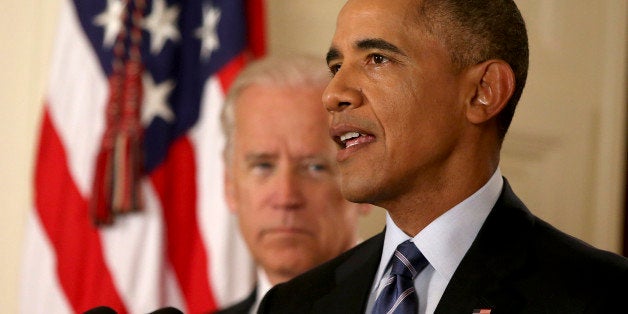
The remarkable fact about the accord just reached with Iran is that President Obama and John Kerry achieved it by their determination to jump the track -- to make at least one course change in the futile policies that American leaders have been following for decades in the Greater Middle East as if they were mindless automatons.
Automatons like the mechanical figures on the glorious Torre del Orologio in Saint Marks Square in Venice, where, every hour, two life size bronze figures wheel around to strike a huge bell, to the delight of crowds below. On Ascension Week and Epiphany, carved representations of the four Magi also emerge to trundle round the parapet, bowing to the Virgin Mary. A mechanical angel dutifully raises a trumpet and the Magi bow again in return.
They've repeated this ritual for centuries and, barring some catastrophe, they'll keep on performing it as long as their mechanisms are oiled and maintained. That's what automatons do.
That's the predictable process that also has been going on over a large swathe of the planet for the past many years. It's driven by many forces, including America's obsessive attempts to mold the political systems of Muslim states half way across the globe -- and repeatedly failing in the process.
It's like an endless loop. The only thing that changes is that the tragedy becomes ever more horrific, the squandering of lives and resources ever more outrageous.
Take Afghanistan, where the U.S. has poured in more than one hundred billion dollars in non-military aid since 2002. To monitor that aid, the U.S. Congress wisely set up an organization known as SIGAR-the Special Inspector General for Afghanistan Reconstruction.
Regular as clockwork, every few weeks, SIGAR's gimlet eyed investigators issue scathing detailed reports on how billions devoted to grandiose American projects in Afghanistan -- from road and school construction to poppy eradication -- have gone down the tubes.
And just as predictably, the U.S. continues to pour in vast sums, often to those same discredited programs.
The latest SIGAR report examines what happened to more than one billion dollars that the U.S. has lavished to "to develop the rule of law in Afghanistan."
It concludes that the U.S. agencies involved have dolled out huge amounts without any coordinated strategy, any real idea of what they were out to achieve, nor did they have anyway of measuring to what degree -- if any -- they've been successful.
According to SIGAR -- to no one's surprise -- one of the major problems is the "pervasive corruption in Afghanistan's justice sector." The problem remains deeply embedded, because "among other things, the Afghan government has lacked the political will and commitment to tackle corruption in the justice system."
Afghanis in fact, "viewed the formal justice institutions as the most corrupt public institutions in Afghanistan..." Indeed, SIGAR concludes, the problem may have actually become worse, since the U.S. began its aid program.
American officials also admitted that -- even as they continued to pour hundreds of millions of dollars more into reforming the justice and prison system, they are not at all convinced that the Afghan government itself either wants or supports those American imposed changes.
In one program, according to SIGAR, "USAID doubled funding even though it knew the Afghan Supreme Court was not interested in funding or in sustaining those activities."
Meanwhile, in Syria, the U.S. is on another dead-end course.
In May 2014, the U.S. Congress, impatient for America to do something to challenge the spectacular advances of the Islamic State in Syria, authorized the Pentagon to spend $500 million dollars to raise a "moderate" army to defeat ISIL. The goal was to find and train 5,000 soldiers per year for three years.
One year later, how many "moderates" have been trained? About 60 soldiers, according to Secretary of Defence Ashton B. Carter.
I figure that comes to a mind-boggling 2.7 million dollars per "moderate soldier!"
(Since the $500 million funds a three-year program, that equals about $166,666,000 per year, which, divided by 60, comes to $2.777 million dollars per soldier.)
The Kafkaesque dilemma of the people running that program is to find recruits who somehow meet the definition of "moderate" as proclaimed by the distant U.S. Congress -- but men who are also dedicated enough to fight against the jihadists of ISIL, but not the army of Assad -- a dictator who most Syrians despise even more than ISIL, but who the U.S. is not currently targeting -- at least, not with boots on the ground.
There's another catch: these "moderates" are also being recruited without any assurances that, when and if they actually go to battle, the U.S. will be there to back them up.
Thus, if the day ever comes that Assad collapses, the U.S. will have no chips of its own to play -- no force representing the majority of Syrians who -- we are told -- reject the extremists -- but have no trained army of their own.
Which means that, if Assad were to fall and Sunni extremists were to take over, the U.S. would probably find itself on the same side as Assad's major supporter today -- Shiite Iran.
Which is no longer such a startling proposition, particularly if the nuclear deal just brokered with Iran can stick,
That's what has happened in Iraq, where Iran plays a major role combatting the Islamic State.
There also, however, the U.S. had been on a futile treadmill, pouring more than $25 billion into training and equipping an Iraqi army, only to see it crumble like a sand castle in 2014 when the tide -- in this case -- ISIL -- came in.
Just the same, President Obama decided to start the game all over again. He deployed 3,500 U.S. personnel to Iraq to train a new Iraqi army. (Another interesting bit of math: Since each U.S. trainer requires nine other American personnel for back-up, that means only 400 of the 3,500 U.S. Personnel are actually instructing Iraqi forces in the field.)
Talk about déjà vu, some of the "new" American trainers have already done four or more tours of duty in Iraq -- training the Iraqi army.
So far, the new program has been a major disappointment. The support of Sunni tribesmen is considered vital, but just 1,300 have been recruited and trained, along with 8,800 Iraqi army and Kurdish militia soldiers.
Still the program goes on, despite the fact that everyone admits the problem is not a question of creating a new army -- nor having more effective American air support -- but having an honest, non-sectarian government in Baghdad that Iraqi soldiers of all religious stripes would be willing to lay down their lives to defend.
Indeed when you look around the globe, it's obvious that, despite America's huge military might, its hundreds of overseas bases, sophisticated drones, and whack-a-mole assassinations of radical leaders, somehow ISIL has managed to metastasize and grow and attract thousands of new recruits.
When he took office Obama made it clear he realized how much of a treadmill American policy in the Greater Middle East was on. Striking out in just one area, to try something new with Iran, required -- and will continue to require -- tremendous effort and, yes, courage.
Indeed, in order to protect his flank and appease America's traditional allies in the region alarmed by a rapprochement with Iran, Obama continues with many of the same senseless policies of the past: backing down in the face of Israel's on-going settlement program in the West Bank, renewing American aid to brutal dictatorial regimes in Egypt and Bahrain, and supporting the Saudis in their ruthless embargo and air strikes against Yemen, the poorest country in the region.
But who knows, if this new accord with Iran actually leads to real change in relations between Tehran and Washington, it may also generate real changes to more of America's barren policies of the past.
